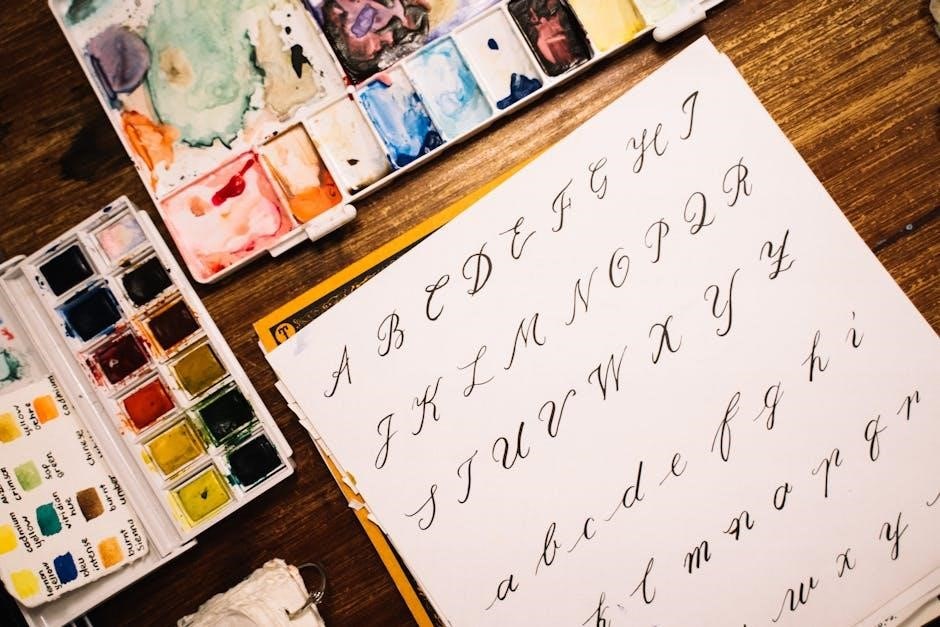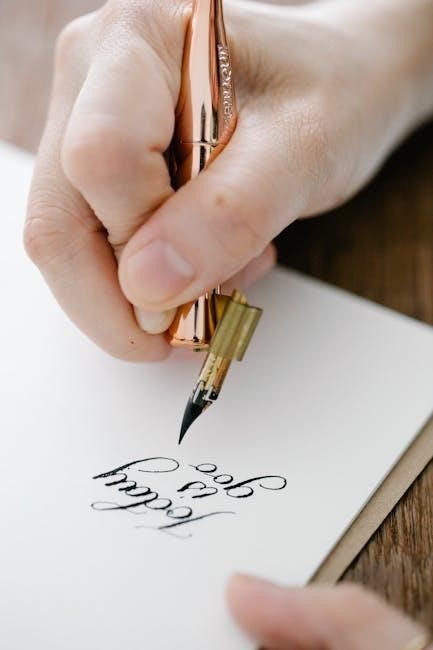lower case letters practice sheets pdf
Lowercase letters practice sheets are essential tools for young learners, providing structured exercises to master alphabets; These worksheets, often in PDF format, offer tracing activities and independent writing spaces to enhance handwriting skills and fine motor control․ Ideal for preschoolers and kindergarten students, they make learning engaging and effective, helping children build a strong foundation in writing․
What Are Lowercase Letters Practice Sheets?
Lowercase letters practice sheets are educational tools designed to help children master the correct formation and writing of lowercase alphabet letters․ These sheets typically feature letter outlines with dotted lines, guiding young learners to trace and practice writing each letter accurately․ Available in PDF formats, they often include space for independent writing, making them ideal for preschoolers and kindergarten students to improve handwriting and fine motor skills․ They are versatile resources for both classroom and home use, providing a structured approach to learning letter formation and enhancing foundational writing abilities in a fun and engaging way․
Importance of Practicing Lowercase Letters
Importance of Practicing Lowercase Letters
Practicing lowercase letters is crucial for developing foundational writing skills in children․ It improves handwriting legibility, enhances fine motor control, and builds muscle memory essential for fluent writing․ Consistent practice helps children recognize and reproduce letterforms accurately, fostering literacy development․ Lowercase letters are more commonly used in daily writing, making their mastery vital for academic success and effective communication․ Regular practice reinforces letter recognition and writing fluency, laying a strong foundation for future educational milestones․
Benefits of Using Lowercase Letters Practice Sheets
Lowercase letter practice sheets enhance handwriting, improve letter recognition, and boost academic performance․ They foster fine motor skills and confidence, making writing more effortless and enjoyable for learners․
Improving Handwriting Skills
Lowercase letter practice sheets significantly enhance handwriting skills by providing structured exercises for tracing and writing․ Regular practice helps children develop proper letter formation, consistency, and control․ These sheets allow learners to transition from guided tracing to independent writing, fostering muscle memory and confidence․ By repeatedly practicing each letter, kids refine their technique, reducing errors and improving legibility․ The consistent use of these resources ensures steady progress in mastering handwriting, making it an essential tool for young learners․
Enhancing Fine Motor Skills
Lowercase letter practice sheets play a crucial role in enhancing fine motor skills, essential for precise handwriting․ Tracing exercises help children develop hand-eye coordination and finger dexterity․ By repeatedly tracing letters, kids strengthen their grip and control over writing tools․ These sheets also introduce activities that refine movement accuracy, making it easier for young learners to master letter formation․ Regular practice fosters better finger independence and overall motor precision, laying a solid foundation for future writing tasks․
Building Muscle Memory for Writing
Lowercase letter practice sheets are instrumental in building muscle memory, a critical component of fluent writing․ Repetitive tracing exercises help children develop consistent letter formation, as their hands learn the specific movements required for each character․ Over time, this repetition creates a mental and physical imprint, making writing feel more natural and automatic․ The structured format of these sheets ensures that learners can focus on precision and consistency, gradually mastering the skills needed for confident handwriting․
How to Choose the Right Lowercase Letters Practice Sheets
Selecting appropriate lowercase letter practice sheets involves considering the learner’s age and skill level․ Look for sheets with clear, large letters and dotted lines for tracing, suitable for young children․ Ensure the content covers all lowercase letters, with repetition for commonly confused letters․ Opt for PDF formats for easy printing and access․ Choose sheets from reputable sources to ensure educational accuracy and alignment with curriculum standards․ Additionally, consider engagement through fun designs and the option for customization to meet individual learning needs․ Accessibility and affordability are also key factors, with free resources being ideal for many families and schools․ Finally, the structure should allow for progression from tracing to independent writing, supporting the child’s learning journey and keeping them motivated․ Customization tools can further enhance the effectiveness of the practice sheets by tailoring them to specific needs and preferences, ensuring a personalized and effective learning experience․
Key Features to Look for in Practice Sheets
When selecting lowercase letters practice sheets, look for clear, large fonts and dotted lines to guide tracing․ Proper spacing between letters prevents overcrowding, while age-appropriate designs keep children engaged; Sheets should include all 26 lowercase letters, with options for both tracing and independent writing․ PDF formats ensure easy printing, and customization features allow tailoring to individual needs․ Interactive elements, like coloring or fun themes, can enhance learning․ Ensure the sheets progress from guided tracing to independent writing, fostering skill development and confidence․
Age-Appropriate Designs for Different Learners
Lowercase letters practice sheets should cater to different age groups, with designs tailored to developmental stages․ Preschoolers benefit from large, simple layouts with visual aids, while older students may prefer more structured, compact formats․ Incorporating fun visuals, such as cartoons or animals, engages younger learners․ For older children, sheets with minimal distractions and clear instructions are ideal․ Age-appropriate designs ensure the content is accessible and engaging, fostering effective learning for all skill levels and preferences․

Free Resources for Lowercase Letters Practice Sheets
Free lowercase letters practice sheets are widely available online, offering PDF downloads for easy printing․ These resources are perfect for classrooms, homeschooling, or independent learning, providing accessible tools for handwriting development․
Popular Websites Offering Free PDF Downloads
Websites like WorksheetsPDF, iStock, and Education․com provide free lowercase letter practice sheets in PDF format․ These sites offer a variety of tracing worksheets, from basic letter outlines to interactive designs․ Parents and educators can easily download and print these resources, making them ideal for classroom activities, homeschooling, or independent practice․ Many sites also include customizable options, ensuring the sheets cater to different learning needs and skill levels, promoting effective handwriting development for children․
How to Download and Print the Sheets
Visit websites offering free PDF downloads, such as WorksheetsPDF or Education․com․ Locate the lowercase letter practice sheets and click the download link․ Save the PDF to your device and open it using a PDF reader․ Ensure your printer is set to the correct paper size, typically 8․5×11 inches․ Print the sheets on standard paper for clear visibility․ Adjust printer settings if needed for optimal quality․ These steps ensure easy access to practice materials for handwriting improvement․

Creating Custom Lowercase Letters Practice Sheets
Visit websites like WorksheetsPDF or Education․com to access free PDFs․ Click the download link, save the file, and open it with a PDF reader․ Print the sheets on standard paper for clear visibility, ensuring proper formatting․ Adjust printer settings if necessary for optimal quality․ This straightforward process provides easy access to practice materials, helping children improve their handwriting skills effectively․
Tools and Software for Making Custom Worksheets
Utilize tools like Canva or Microsoft Word to design custom lowercase letter practice sheets․ Online platforms such as Worksheet Generator or Google Docs offer templates for creating personalized worksheets․ For more advanced designs, consider graphic design software like Adobe Illustrator․ These tools allow users to tailor practice sheets to individual learning needs, ensuring engaging and effective handwriting exercises for children․
Personalizing Sheets for Individual Learning Needs
Personalizing lowercase letter practice sheets allows educators and parents to cater to specific learning needs․ Customize letter size, font style, and spacing to suit visual preferences․ Incorporate images or color-coded letters to enhance engagement․ For learners with special needs, focus on high-contrast designs or larger print․ Tailor worksheets to address particular challenges, such as letter formation or spacing․ This customization ensures targeted practice, fostering progress and confidence in young writers․

Tracing vs․ Independent Writing in Practice Sheets
Tracing exercises guide learners with dotted lines, while independent writing spaces allow practice without assistance․ This progression helps develop fine motor skills and letter formation confidence gradually;
Guided Tracing Exercises
Guided tracing exercises in lowercase letters practice sheets provide dotted lines for each letter, helping learners understand proper letter formation․ These exercises are ideal for young children, as they offer a clear visual guide to follow․ By tracing, kids develop fine motor skills and hand-eye coordination․ The structured approach ensures consistent practice, leading to legible handwriting․ Many PDF worksheets include tracing exercises for the entire alphabet, making it easy to download and print for classroom or home use․ Tracing also builds muscle memory, preparing children for independent writing confidently and accurately․
Blank Spaces for Independent Practice
Blank spaces for independent practice in lowercase letters worksheets allow children to write letters on their own, applying what they’ve learned․ These sections, often without dotted lines, enable kids to demonstrate their understanding and skill․ They provide an opportunity for self-assessment and reinforce muscle memory, helping transition from guided tracing to confident writing․ Many PDF sheets include blank lines, making it easy for children to practice independently after mastering tracing exercises, fostering independence and self-reliance in handwriting development․

Developing Fine Motor Skills Through Practice Sheets
Lowercase practice sheets offer exercises that enhance grip, control, and dexterity․ These activities improve fine motor skills, essential for childhood development and mastery of handwriting․
Exercises for Better Grip and Control
Practice sheets often include tracing exercises and dot-to-dot activities that help children develop a better grip on writing tools․ These exercises strengthen finger muscles, improving dexterity and precision․ Tracing lowercase letters with guided lines enhances control, while connecting dots in letter shapes refines motor accuracy․ Such activities gradually build confidence, allowing children to transition from assisted tracing to independent writing seamlessly․ Regular practice fosters better hand-eye coordination and overall writing readiness․
Activities to Improve Dexterity
Practice sheets feature activities like tracing patterns, connecting dots in letter shapes, and following lines or curves․ These exercises enhance finger control and coordination, crucial for writing․ Tracing lowercase letters with directional arrows teaches proper letter formation, while maze-like patterns improve precision․ Such tasks gradually refine motor skills, enabling children to handle writing tools with greater accuracy and confidence, preparing them for independent writing tasks effectively․

Using Lowercase Letters Practice Sheets in the Classroom
Teachers can integrate lowercase letter practice sheets into daily lesson plans, enhancing students’ handwriting and fine motor skills through structured tracing exercises and group activities․
Incorporating Practice Sheets into Lesson Plans
Teachers can seamlessly integrate lowercase letter practice sheets into their lesson plans by dedicating specific time slots for tracing and writing exercises․ These sheets can be used as warm-up activities or as part of a structured handwriting curriculum․ By incorporating them into daily routines, educators can help students develop consistency in letter formation and spacing․ Additionally, practice sheets can be paired with interactive group activities to make learning engaging and collaborative, ensuring all students benefit from targeted practice․
Group Activities for Collaborative Learning
Engaging group activities with lowercase letter practice sheets foster teamwork and fun learning․ Students can work in pairs to trace letters together, creating collaborative posters or comparing their progress․ Teachers can organize competitions where teams race to trace letters accurately; Group discussions on letter formation and sharing tips enhance understanding․ These activities promote peer learning, making practice sessions enjoyable and effective, while encouraging students to support one another in mastering lowercase letters․

Using Lowercase Letters Practice Sheets at Home
Lowercase letter practice sheets are valuable at home, enabling parents to guide their children’s learning․ They encourage daily routines, making handwriting practice a fun, bonding experience for families․
Parental Involvement in Practice Sessions
Parental involvement significantly enhances the effectiveness of lowercase letter practice sessions at home․ Parents can guide their children through tracing exercises, provide feedback, and create a supportive environment․ By actively participating, parents help build confidence and ensure consistent progress․ Regular interaction also allows parents to identify areas where their child may need additional practice, fostering a collaborative learning experience that is both enjoyable and productive for young learners․
Creating a Daily Routine for Practice
Establishing a consistent daily routine is crucial for effective practice with lowercase letters; Set aside a specific time each day for your child to work on their practice sheets․ Begin with guided tracing activities and gradually transition to independent writing․ Incorporate fun elements, such as tracing letters with different colors or tools, to keep sessions engaging․ Regular practice, even for short periods, helps build muscle memory and improves handwriting skills over time․
Tips for Effective Practice with Lowercase Letters
Set clear goals, use proper grip techniques, and incorporate fun activities to keep sessions engaging․ Regular practice and positive reinforcement boost progress and confidence․
Setting Goals and Tracking Progress
Setting specific, achievable goals helps structure practice sessions, ensuring steady improvement․ Use progress charts or journals to track development, celebrating small milestones․ This method keeps learners motivated and focused․ Regularly reviewing work highlights areas needing attention, allowing adjustments to practice routines․ By monitoring progress, children gain confidence and a sense of accomplishment, fostering a positive attitude toward learning․ Consistent tracking also helps identify patterns and strengths, guiding future practice effectively․
Making Practice Fun and Engaging
Incorporate colorful designs, tracing games, and interactive activities to make lowercase letter practice enjoyable․ Use themed worksheets, like animals or cartoons, to captivate young learners․ Digital tools and apps offer engaging ways to practice, combining learning with play․ Reward systems, such as stickers or stars, motivate children to complete tasks․ Mixing traditional and creative methods keeps practice sessions lively, ensuring kids stay excited about mastering lowercase letters while developing essential skills․

Lowercase Letters Practice Sheets and Technology
Technology enhances lowercase letter practice with apps and digital tools, offering interactive tracing exercises and immediate feedback, making learning engaging and effective for children․
These digital resources provide a modern approach to mastering handwriting skills․
Digital Tools for Handwriting Practice
Digital tools like apps and software offer interactive ways to practice lowercase letters․ They provide guided tracing exercises, immediate feedback, and progress tracking․ These tools engage children with animations and games, making learning fun․ Many apps allow customization, catering to individual needs․ Parents and educators can monitor improvement through detailed reports․ Digital tools complement traditional worksheets, offering a modern, flexible approach to mastering handwriting skills․ They are accessible on tablets and smartphones, making practice convenient and enjoyable for young learners․
Interactive Apps for Letter Tracing
Interactive apps for letter tracing offer engaging ways to practice lowercase letters․ They feature animations, games, and rewards to keep children motivated․ Many apps provide step-by-step tracing guides, allowing kids to practice at their own pace․ Some include voice instructions and instant feedback to correct mistakes․ These apps often allow customization, such as selecting specific letters to focus on․ They are accessible on tablets and smartphones, making practice convenient and enjoyable for young learners․ Interactive apps make handwriting fun and effective, helping children develop muscle memory and confidence in writing lowercase letters․

Assessing Progress with Practice Sheets
Regularly reviewing completed practice sheets helps track improvement in letter formation and consistency․ Setting goals and comparing work over time reveals progress and areas needing more practice;
Monitoring Improvement Over Time
Regularly reviewing practice sheets helps track progress in handwriting consistency and letter formation accuracy․ By comparing earlier and recent worksheets, parents and educators can identify improvements in fine motor skills and muscle memory․ Progress tracking charts or milestone markers can highlight advancements, while digital tools offer interactive ways to monitor development․ Over time, consistent practice leads to better letter recognition and writing fluency, making lowercase letters practice sheets an invaluable educational resource for young learners․
Identifying Areas for Further Practice
By reviewing completed practice sheets, educators and parents can pinpoint letters that are challenging for learners․ Common mistakes, such as inconsistent letter formation or sizing, highlight areas needing extra focus․ For example, letters like ‘b’ and ‘d’ are often confused due to similar shapes․ Customizing practice sheets to target these specific letters ensures tailored learning; Regular assessment helps refine skills, guiding learners toward mastery of lowercase letters with precision and confidence over time․

Common Challenges and Solutions
Common challenges include letter formation errors and inconsistent sizing․ Solutions involve guided tracing exercises and using dotted lines to improve accuracy and fine motor skills effectively․
Overcoming Difficulties in Letter Formation
Many children struggle with letter formation due to lack of practice or poor fine motor control․ Using lowercase letters practice sheets with dotted lines helps guide strokes correctly․ Tracing exercises build muscle memory, while blank spaces allow independent practice․ Breaking letters into simple strokes and providing visual examples can aid understanding․ Encouraging daily practice and offering positive feedback fosters confidence․ These tools help children master letter shapes and improve handwriting consistency over time․
Addressing Common Mistakes in Lowercase Letters
Children often struggle with letter formation, such as confusing similar shapes like ‘b’ and ‘d’ or ‘p’ and ‘q’․ Practice sheets with dotted lines guide correct tracing, helping to fix errors․ Blank spaces allow independent writing, revealing areas needing improvement․ Positive reinforcement and targeted feedback encourage progress․ Regular use of lowercase letters practice sheets helps children overcome these challenges, ensuring proper letter formation and consistency in handwriting over time․
Lowercase letters practice sheets are invaluable tools for mastering handwriting skills, offering structured exercises to enhance accuracy and confidence in young learners, adaptable for both home and classroom use․
The Role of Practice Sheets in Mastering Lowercase Letters
Practice sheets play a crucial role in helping children master lowercase letters by providing structured exercises for tracing and independent writing․ They enhance fine motor skills, build muscle memory, and improve handwriting accuracy․ With free PDF downloads available, these sheets offer versatility for both home and classroom use․ By bridging guided tracing and independent practice, they foster confidence and proficiency in writing lowercase letters effectively․
